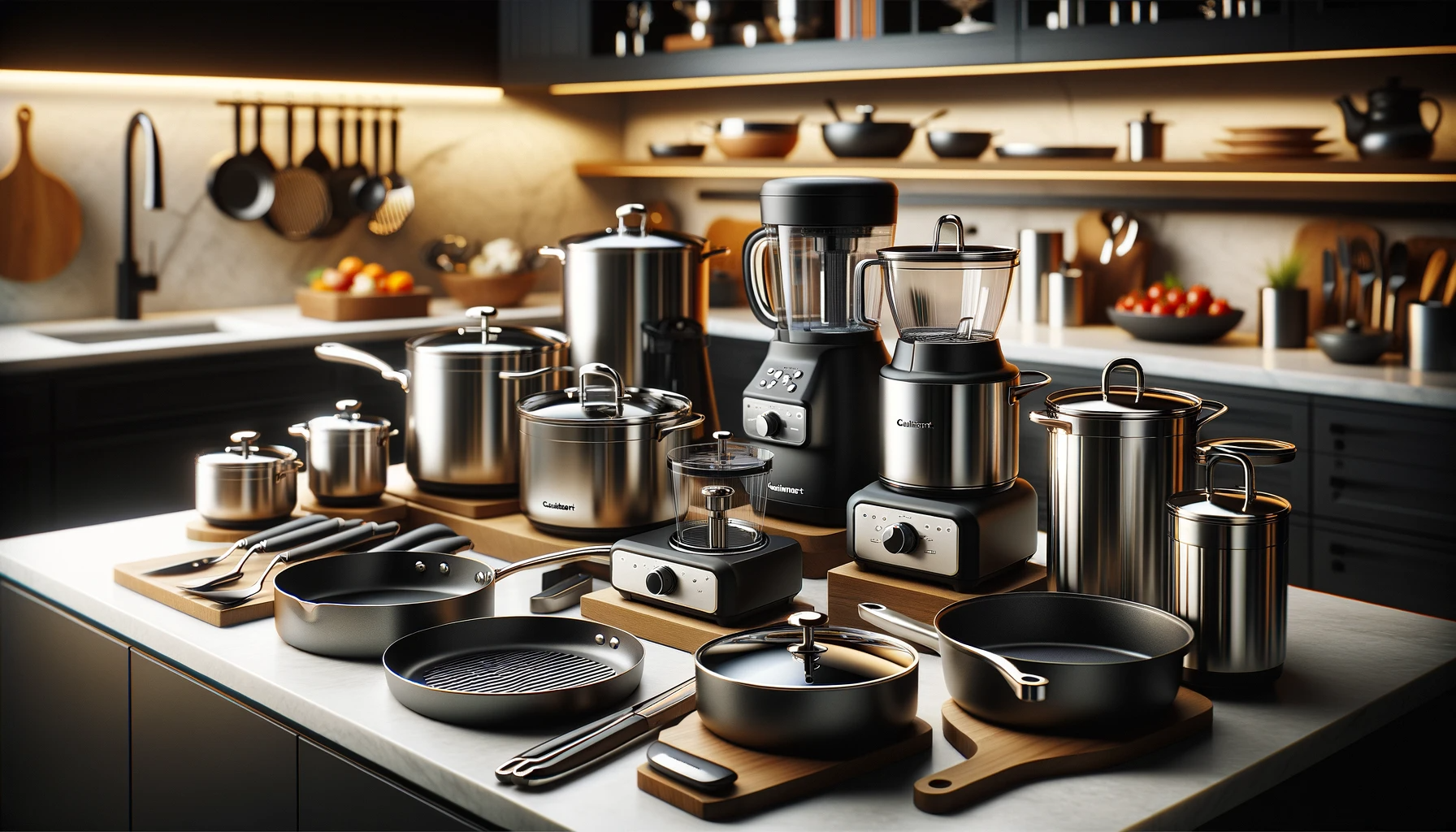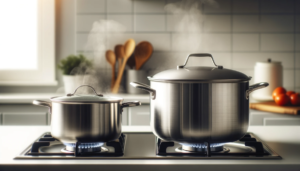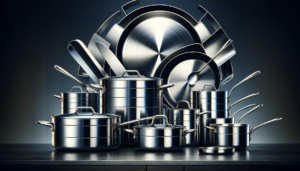When biting into a perfect golden brown steak seared in a pan with flawless fond or tasting a silky smooth soup that has simmered to perfection, we rarely ponder where these essential cooking vessels originate.
But understanding the manufacturing origins and material integrity behind cookware from beloved brand Cuisinart reveals what makes their pots and pans true kitchen workhorses.
Let’s uncover where the majority of Cuisinart cookware products are made and how the brand maintains its reputation for quality and reliability from factories overseas to your stovetop.
Where is Cuisinart Cookware Made?

The majority of all Cuisinart pots, pans, and other cookware products originate from contract manufacturing facilities based in China.
The brand works with selected factories in China to produce its extensive lines of stainless steel and nonstick cookware.
These overseas operations facilitate large-scale manufacturing while a small team in the United States handles critical product design.
Now let’s explore the details behind this production arrangement and Cuisinart’s commitments to quality.
History of Cuisinart

Cuisinart was founded in 1971 by the late Carl Sontheimer.
Mr.Sontheimer introduced the food processor to the United States consumer food market.
The launch of this innovative new kitchen appliance pioneered an entirely new category for food preparation appliances.
Based in Connecticut, Cuisinart was acquired by Conair Corporation in 1989 and has continued to expand its collections of food preparation appliances along with cookware and cutlery products.
The brand is especially known for being the first to introduce the food processor to American home cooks back in the 1970s.
This kitchen appliance was completely unfamiliar to consumers at the time but ended up starting a revolution in terms of how home cooks approached food preparation.
Cuisinart’s well-designed, affordable food processors became hugely popular.
And the company has continued building on this reputation for quality food preparation appliances ever since.
Cuisinart’s Manufacturing Process

While Cuisinart started out as an American company based in Connecticut, today most Cuisinart products are manufactured overseas.
When it comes to Cuisinart’s extensive lines of stainless steel cookware, these products are made primarily in factories located in China.
Labor costs are considerably lower in China, which allows the brand to offer quality cookware at reasonable prices.
The Chinese factories Cuisinart utilizes have been carefully selected and are reportedly subject to strict quality control standards and protocols.
Working conditions and wage policies at Cuisinart’s supplier factories are also intended to safeguard against any labor or human rights concerns.
The factories are required to adhere to rigorous safety, wage, and overtime regulations.
While moving operations overseas was likely done to control costs, Cuisinart’s parent company Conair maintains that working with reputable manufacturers leads to the best products quality and consistency.
While Cuisinart cookware may be produced abroad, design and engineering is said to still occur at Cuisinart’s headquarters in the United States.
The product concepts, specifications, and detailed requirements for the cookware are all created by the company’s experienced product development team.
These designs are then carefully translated into production and manufacturing oversight at the contracted factories in China, enabling full-scale production of some of the most popular cookware choices for home kitchens today.
Quality and Materials

Cuisinart’s staple cookware lines consist primarily of aluminum and stainless steel constructions that balance durability with even heat distribution properties.
The brand’s cookware stands out from cheaper options thanks to its clever uses of metal layers and components.
Several collections utilize hard anodized aluminum that has been reinforced with electrochemically applied layers for extra resilience and longevity or stainless steel countered with an encapsulated aluminum base or core to enhance heat conductivity.
Cookware items commonly feature riveted stainless steel handles to complement the stainless steel pots and pans.
Many of the sets incorporate shatter-resistant glass lids to allow for monitoring cooking progress without losing heat or moisture.
Higher-end selections may also incorporate special interior or exterior coatings like titanium or enamel for additional nonstick performance or aesthetic appeal in the kitchen.
Cuisinart tends to reinforce areas where greater impacts or stress are likely to occur.
Riveted handles can withstand frequent jostling and lifting of pots from stove to oven or stovetop.
Disc-shaped bases or specially-designed triple ply constructions ensure the pots and pans sit stably on stove or oven racks.
While overseas manufacturing may have its disadvantages, Cuisinart maintains strict controls over cookware assembly and product integrity before pieces ever leave the factory floor.
Judging from the durable technologies, resolute construction, and overall rave reviews from consumers, Cuisinart appears to deliver consistently on quality and value.
These pieces are meant to hold up to the demands of daily cooking and last through years of regular use.
Product Lines

Within the broader Cuisinart brand umbrella are several lines that cater to all sorts of cooking needs, styles, and budgets.
Some of the most popular Cuisinart cookware collections include:
Multiclad Pro Stainless
The Multiclad Pro range takes advantage of triple-ply metal layering with an aluminum core.
The resulting stainless steel exterior and cooking surface quietly conducts and spreads heat evenly and efficiently thanks to the highly responsive aluminum center.
At the same time, cooking experiences are familiar, consistent, and truly professional thanks to the polished stainless steel with a mirror-like finish.
These upgraded multicookers perform exceptionally yet come at a higher price point than basic stainless steel options.
Chef’s Classic Stainless
For more budget-minded buyers, the Chef’s Classic pieces stick to durable stainless steel bodies.
While these pots and pans may not have the tri-ply boost provided by pricier lines’ aluminum or copper cores, the stainless steel alone still offers solid heat distribution and control.
The cookware surfaces brown and sear foods evenly.
And Cuisinart rounds out the collection with ergonomic handles plus tempered glass lids to simplify cooking and monitoring.
Hard Anodized Nonstick
Where extra nonstick slipperiness may be preferred, Cuisinart’s Hard Anodized assortment incorporates unrivalled stick resistance thanks to its electrochemically hardened aluminum.
Food practically glides across these saucepan and skillet cooking surfaces that won’t corrode or react to acidic ingredients.
The dark, distinctive cookware holds its own, standing out with a reinforced nonporous quality that also heats swiftly and evenly.
A hard anodized construction means heightened performance and resilience compared to cheaper, flimsier nonstick alternatives.
Environmental Commitment

As a leading brand for kitchen products sold around the world, Cuisinart and parent company Conair recognize they have a responsibility to operate sustainably.
Cuisinart has prioritized integrating environmental consciousness throughout many facets of the business from manufacturing practices to packaging designs.
Initiatives like reassessing product materials, optimizing logistics networks, and pursuing other planet and business-friendly goals to reduce the overall footprint.
Certain collections like the HeatCeramic cookware utilize safer ceramic coatings and environmentally-responsible manufacturing processes in lieu of traditional petrochemical nonstick products.
Cuisinart is committed to progressively using more sustainable materials to craft high-quality pots and pans in ways that better protect resources, ecosystems, and food safety alike.
In addition to constantly evaluating production systems to minimize harm, share progress, and support employee wellbeing, Cuisinart is also passionate about worthy causes related to cooking, culinary education, and feeding communities.
The brand actively partners with charities like Share Our Strength and Alex’s Lemonade Stand Foundation through promotional campaigns and by sponsoring events and fundraisers that align with its mission to enrich lives through food and cooking.
Buying Authentic Cuisinart

Due to the popularity and successful reputation behind Cuisinart’s cookware collections, there is a robust market for counterfeit or fake products that try to pass themselves off as genuine Cuisinart pieces.
Unsuspecting buyers are tricked into paying full-price for inferior, defective imposter items that simply do not live up to Cuisinart’s standards.
Obviously, this can sour the entire Cuisinart experience.
Customers get stuck with cookware that underperforms at best or at worst, puts their health or safety at risk through toxic chemical leaching or dangerous malfunctions.
Thankfully there are several ways to spot and avoid Cuisinart knockoffs being sold by dubious independent sellers:
Purchase through Authorized Retailers
Whether shopping online or in-store, sticking with authorized national retailers like Amazon, Kohl’s, Bed Bath & Beyond, Target, or Walmart basically guarantees the authenticity of any Cuisinart products.
Big box, specialty, and web retailers have longstanding firsthand supplier partnerships with Cuisinart’s parent company.
They would never risk stocking or selling anything except bonafide merchandise from these cookware collections.
Beware Independent Online Listings
Alternatively, anonymous peer-to-peer marketplaces like eBay, Facebook Marketplace, or Craigslist introduce uncertainty into the shopping process.
Individual sellers might honestly believe they are reselling legitimate Cuisinart products only to later discover their supplier actually peddled fakes.
Or worse, dishonest merchants knowingly deal in counterfeit materials.
Without a major retailer’s chain of custody to vouch for authenticity, it becomes an unsafe gamble.
Customers have no reliable way to verify these supposed Cuisinart goods aren’t cheap knockoffs.
Inspect Packaging and Components
Before making a purchase, carefully check any available images of the actual Cuisinart cookware up for sale and determine if subtleties in packaging, branding, construction are suspect.
Things like mismatched logos, poor grammar, broken English descriptions, flashy font mismatches or oddly sized pots raise red flags.
Shoddy craftsmanship, rough welds, thin low-grade metals signify questionable non-Cuisinart origins as well.
But also know even the best counterfeiters try spoofing convincing packaging and imitating premium details now so this alone doesn’t guarantee an item’s authenticity.
Ultimately the best way to become a satisfied Cuisinart cookware owner is working directly through an authorized retailer in the first place.
Big names like Amazon or direct from Conair itself should inspire customer confidence in an item’s legitimacy well before it ever reaches the front door.
Conclusion
As one of the most trusted and pioneering names in kitchen appliances and cookware, Cuisinart remains committed to quality and innovation from design to end result.
While manufacturing largely resides overseas, Cuisinart strives to partner with factories that align with its standards for worker welfare and environmental values.
Savvy home cooks can continue enjoying the performance and reliability synonymous with Cuisinart through authorized retailers rather than risking counterfeit cookware.
When you support genuine Cuisinart cookware, you invest in cookware made to last.



